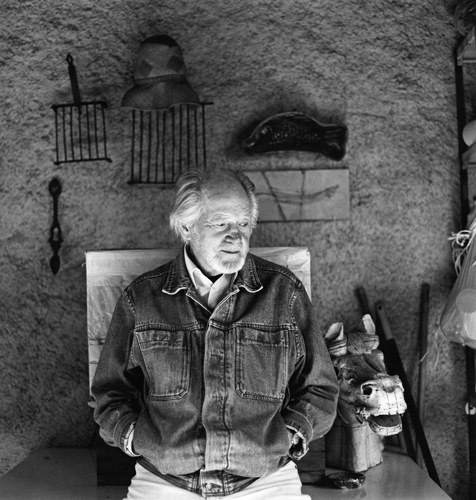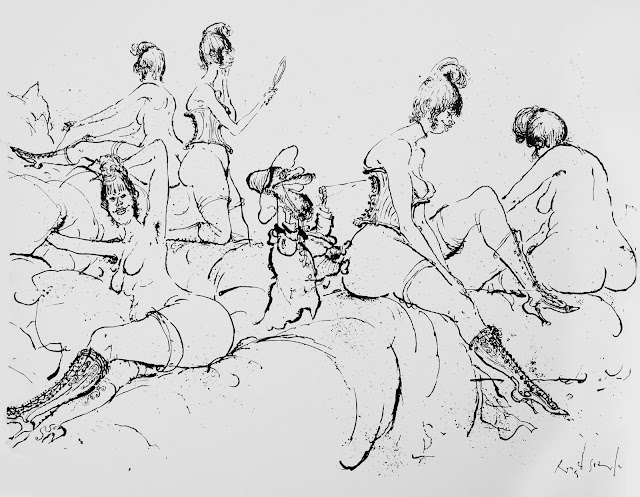The son of a railwayman, Ronald Searle was born in Cambridge on 3 March 1920, and educated in the town at the Boys' Central School. He started work as a solicitor's clerk, and then joined the hire purchase department of the co-operative Society, studying in the evenings and later full-time at the Cambridge Daily News from the age of fifteen.
Enlisting in the Royal Engineers at the outbreak of the Second World War, he spent time in Kirkcudbright, where he encountered evacuees from St. Trinian's, a progressive girls' school situated in Edinburgh.This resulted in his first cartoon for Lilliput, published in October 1941, and later developed into one of his most famous creations, through a series of books and their cinematic spin-offs. Remarkably, he survived the horrific experiences of the Changi Camp, Singapore as a Japanese prisoner-of-war and managed to produce a visual record of life in a prison camp.
On his return to England in 1945, he exhibited the surviving pictures at the Cambridge School of Art, and published Forty Drawings. The exhibition and volume together established his reputation as one of Britain's most powerful draughtsmen, and led to several opportunities to record the atmosphere of post-war Europe. He contributed to Punch and these drawings crystallised in, The Female Approach (1949). Throughout the fifties, he produced a large variety of illustrations, which together seemed present a guide to life in Britain in the 1950's.
Such was his success that his rejection of family and country in a move to Paris in 1961 came as a great surprise. However, it offered a fresh start, resulting in several solo shows, including a major exhibitions at the Bibliotheque Nationale, Paris, the Berlin-Dahlem Museum and the Wilhelm-Busch-Museum, Hanover. He also reached a new audience with his contributions to film and television, most notably The Magnificent Men in their Flying Machines (1965).
Note: Searle did too many works to post in one series, so I am posting them in two separate series: 1940-1960, and 1961-2007.
For a more detailed biography see part 1, and for earlier works, see parts 1 - 13 (series 1) & parts 14-17 (series 2)
This is part 18 of a 26-part series on the works of Ronald Searle:
1969 Hello-Where Did All the People Go? published by Stephen Greene Press, Brattleboro, Vermont, USA:
1969 The Second Coming of Toulouse-Lautrec: published by Weidenfeld and Nicolson, London. First published as Hommage à Toulouse Lautrec by Édition Empreinte, Paris:
 |
| Front Cover |
 |
| Title Page |
 |
| Jacob's Ladder |
 |
| Jacob's Ladder |
 |
| Jacob's Ladder |
 |
| Jacob's Ladder |
 |
| Moses in the bullrushes |
 |
| Samson demolishing the Temple |
 |
| Samson demolishing the Temple |
1970 The Adventures of Baron Munchausen:
 |
| Front Cover version 1 |
 |
| Front Cover version 2 |
1970 The Great Fur Opera:
 |
| Front Cover |
 |
| Title Pages |
-------------------------------------------------------------------
 |
| 1969 Filles de Hambourg: Front Cover |
 |
| 1969 Monte Carlo Or Bust: published by Dennis Dobson, London |
 |
1969 The New Yorker: May 3 cover
|
 |
| 1970 Ginette Spanier, directrice of Paris fashion house Balmain |
 |
1970 Hommage à Mickey
Wilhelm Busch - Deutsches Museum für Karikatur und Zeichenkunst
© The Ronald Searle Cultural Trust |
































































No comments:
Post a Comment
Note: only a member of this blog may post a comment.